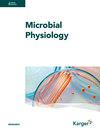Assembly of Bacillus subtilis Dynamin into Membrane-Protective Structures in Response to Environmental Stress Is Mediated by Moderate Changes in Dynamics at a Single Molecule Level
IF 1.2
4区 生物学
Q2 BIOTECHNOLOGY & APPLIED MICROBIOLOGY
引用次数: 1
Abstract
Dynamin-like proteins are membrane-associated GTPases, conserved in bacteria and in eukaryotes, that can mediate nucleotide-driven membrane deformation or membrane fusion reactions. Bacillus subtilis’ DynA has been shown to play an important role in protecting cells against chemicals that induce membrane leakage, and to form an increased number of membrane-associated structures after induction of membrane stress. We have studied the dynamics of DynA at a single molecule level in real time, to investigate how assembly of stress-induced structures is accompanied by changes in molecule dynamics. We show that DynA molecule displacements are best described by the existence of three distinct populations, a static mode, a low-mobility, and a fast-mobile state. Thus, DynA is most likely freely diffusive within the cytosol, moves along the cell membrane with a low mobility, and arrests at division sites or at stress-induced lesions at the membrane. In response to stress-inducing membrane leakage, but not to general stress, DynA molecules become slightly more static, but largely retain their mobility, suggesting that only few molecules are involved in the repair of membrane lesions, while most molecules remain in a dynamic mode scanning for lesions. Our data suggest that even moderate changes in single molecule dynamics can lead to visible changes in protein localization patterns.枯草芽孢杆菌Dynamin在环境胁迫下组装成膜保护结构是由单分子水平上的适度动力学变化介导的
Dynamin样蛋白是膜相关的GTP酶,在细菌和真核生物中保守,可以介导核苷酸驱动的膜变形或膜融合反应。枯草芽孢杆菌的DynA已被证明在保护细胞免受诱导膜渗漏的化学物质的侵害方面发挥着重要作用,并在诱导膜应激后形成数量增加的膜相关结构。我们在单分子水平上实时研究了DynA的动力学,以研究应力诱导结构的组装如何伴随分子动力学的变化。我们表明,DynA分子位移最好用三种不同种群的存在来描述,即静态模式、低迁移率和快速迁移状态。因此,DynA很可能在胞质溶胶内自由扩散,以低迁移率沿着细胞膜移动,并在分裂位点或膜上应激诱导的损伤处停止。作为对应力诱导的膜渗漏的反应,而不是对一般应力的反应,DynA分子变得稍微更静态,但在很大程度上保持了它们的流动性,这表明只有少数分子参与了膜损伤的修复,而大多数分子仍处于动态模式扫描损伤。我们的数据表明,即使单分子动力学的适度变化也会导致蛋白质定位模式的明显变化。
本文章由计算机程序翻译,如有差异,请以英文原文为准。
求助全文
约1分钟内获得全文
求助全文

 求助内容:
求助内容: 应助结果提醒方式:
应助结果提醒方式:


